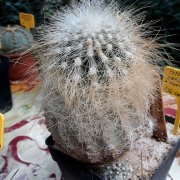Care of the cacti Copiapoa krainziana or Copiapoa scopulina |
|
The genus Copiapoa, family Cactaceae, comprises 25 species of cactus native to northern Chile. Some species are: Copiapoa krainziana, Copiapoa humilis, Copiapoa grandiflora, Copiapoa echinoides, Copiapoa cinerea, Copiapoa calderana, Copiapoa malletiana, Copiapoa gigantea, Copiapoa coquimbana, Copiapoa taltalensis, Copiapoa marginata. This species is native to San Ramon Valley, Chile. They are small cacti of grayish green or brown color with a globose or cylindrical body that reach 20 cm (7.87") in diameter; they can form colonies 1 meter (3.28 feet) wide. They have 13-24 ribs with conical tubercles. 12-30 long spines (3.5 cm/1.37" long) of white, gray or black color appear on the white areolas. The flowers can be pink or white. Copiapoa scopulina is used in pots and planters for terraces, patios, windows or well-lit and ventilated interiors. Copiapoa krainziana prefers direct sun exposure and low humidity. The winter temperature should not be less than 5 ºC (41 ºF). The soil can be a mixture, in equal parts, of clay garden substrate, vermiculite, and coarse siliceous sand. Always water moderately, waiting for the substrate to be completely dry. Don't need to prune or fertilize. Copiapoa krainziana is sensitive to excess moisture that causes rotting of tissues and roots. Copiapoa scopulina propagates by seeds sown in spring or by rooting suckers. |
Images of the cacti Copiapoa krainziana or Copiapoa scopulina |
Find plants
Copiapoa krainziana or Copiapoa scopulina | Care and Growing
© 2025 FavThemes

